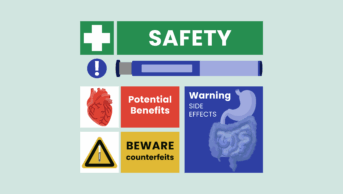A new safety concern has emerged in UK pharmacy practice following launch of the gastro-resistant posaconazole powder for oral suspension (Noxafil 300 mg gastro-resistant powder and solvent for oral suspension; Merck Sharp and Dohme). This product, now licensed for paediatric patients from the age of two years, differs fundamentally in dosing and bioavailability from the existing posaconazole oral suspension (Noxafil 40 mg/mL oral suspension; Merck Sharp and Dohme). These formulations are not interchangeable and require careful differentiation at prescribing and dispensing stage1.
The issue is straightforward but clinically significant: two distinct posaconazole oral suspensions with different bioavailability, dosing regimens and instructions for use now coexist in many UK pharmacies and clinical systems. The older, less bioavailable suspension (40 mg/mL) remains on local formularies and in stock, whilst the newer gastro-resistant suspension (30 mg/mL) has been licensed to align with tablet dosing. These are not interchangeable.
Despite prior alerts from the Medicines and Healthcare products Regulatory Agency (MHRA) in September 2016, which focused mainly on distinction between tablets and suspension, the recent introduction of a third oral formulation has renewed the risk of product mis-selection2.
Our local antimicrobial stewardship team recently identified a near-miss incident in October 2025, where the older liquid was selected instead of the newly licensed gastro-resistant powder, posing a substantial risk of under-dosing. This reflects wider concerns raised in stewardship discussions nationally3.
Notably, the gastro-resistant powder is more expensive, not universally available on formulary and likely to coexist with the older suspension for some time. While original oral suspension has noted issues with its bioavailability and the demand for a superior formulation is high, cost pressures in the NHS will make accessibility to this newer agent challenging. The older suspension has poor bioavailability and must be taken with a high-fat meal to boost exposure by an astonishing 400%4. This requirement — three times daily — can be challenging for many patients.
The latest BNFC update in October 2025 reflects the gastro-resistant powder, but generic posaconazole oral suspension entries and the older suspension are still present in various formularies and electronic prescribing systems. A box warning exists in BNFC, yet practical confusion persists.
We recommend a renewed nationwide awareness campaign by pharmacy teams and the MHRA, covering the full range of posaconazole formulations. Clinical systems must make the distinction clear via naming conventions and embedded dosing guidance, including within ePMA platforms. Pharmacy staff are urged to review local inventories and prescribing menus to minimise risk. Additionally, incidents should be reported to the MHRA Yellow Card scheme to inform further regulatory action.
Stephen Hughes, antimicrobial stewardship lead at Chelsea and Westminster NHS Foundation Trust
Orlagh McGarrity, antimicrobial stewardship pharmacist at Great Ormond Street Hospital NHS Foundation Trust
- 1.Rush C, Duty A. The Pitfalls and Opportunities With Posaconazole DR Oral Suspension. The Journal of Pediatric Pharmacology and Therapeutics. 2025;30(3):410-413. doi:10.5863/jppt-24-00018
- 2.Posaconazole (Noxafil): tablets and oral suspension are not directly interchangeable. Medicines and Healthcare products Regulatory Agency. September 2016. Accessed October 2025. https://www.gov.uk/drug-safety-update/posaconazole-noxafil-tablets-and-oral-suspension-are-not-directly-interchangeable
- 3.Direct Healthcare Professional Communication: Noxafil (posaconazole) gastro-resistant powder and solvent for oral suspension. Merck Sharp & Dohme. August 2024. Accessed October 2025. https://assets.publishing.service.gov.uk/media/67165d4a583ef2380ad99816/noxafil.pdf
- 4.Chen L, Krekels EHJ, Verweij PaulE, Buil JB, Knibbe CAJ, Brüggemann RJM. Pharmacokinetics and Pharmacodynamics of Posaconazole. Drugs. 2020;80(7):671-695. doi:10.1007/s40265-020-01306-y


